Our Biking Adventures started when he was 8 years old.

I then blinked and all of a sudden he is 15 with a girlfriend and one year away from getting his bike license. After that, who knows? With the freedom own wheels bring he'll be off doing his own thing and we'll have to coordinate schedules to do a bike trip together. He grew up so quickly.
So when an opportunity arose to fetch a bike from Cape Town the wheels started turning. A plan for a last ride with him as pillion. We'd take the trusty TransAlp (which sees way too little action these days) and travel on as many gravel roads as possible from the Southern Cape to Cape Town, pick up the test bike and return on tar (it's that kind of bike). It's not a specific or special route, it's just time spent together.
The plan was set. The bike was ready. The weatherman forecast a 30% chance of rain - no more than 2,5mm throughout the day. And that's only in the first 200km of our route. No problem! We'd be fine. And so the ride started...
Little did we know that the 2,5mm of rain would fall all at once, right on our heads! Barely 50km into our trip and on the first gravel we were hit by a torrential shower that soaked us to the bone and turned the road into kilometers of mud.

It doesn't seem bad, but look at the white poles next to the road. This road is being resurfaced and those layers have some nasty habits in the wet. Photo taken during a break in the rain. Luckily the weather cleared up after the wet start and we blew dry as the day went on.
The weather matters not. We're on a trip and this is a beautiful part of the country.

There are several rivers running into the sea along the coast towards Cape Town. The first major one we crossed was the Gourits river. Whenever this river featured in a ride we were jinxed before, so no surprise standing here wet to the underwear. We still need to finish our Gourits ride.
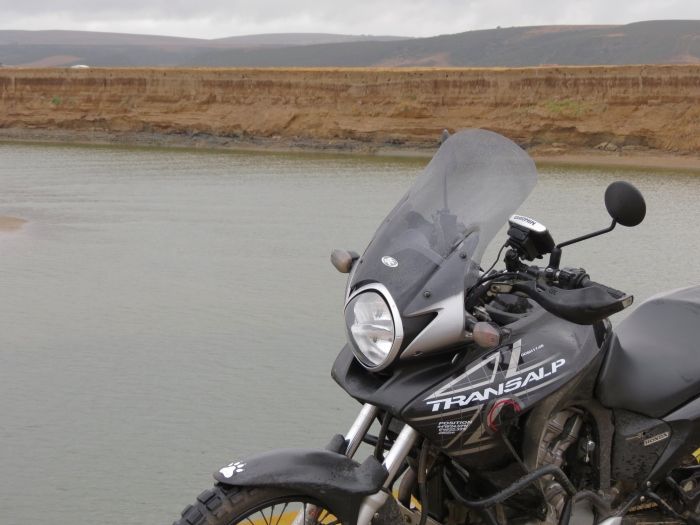
Stilbaai, also known as the Bay of Sleeping Beauty, in the distance:

We were now getting into the rhythm of the ride. The roads improved too. Nice hard packed gravel with little to no traffic. You can get the speed up on these but we were taking our time. We had the whole day after all.

This is the kind of landscape that would be the theme of the day. Riding along only to drop into a ravine towards a river and rise again on the other side. Makes for a scenic and interesting ride. You can see where the river will be in the distance:

On our way down we rode past the sleepy little hamlet called Vermaaklikheid. Vermaaklikheid is just a collection of buildings on the banks of the Duivenshok River, untouched by time. Will be a good place to stay if you just want to get away from everything.

Crossing the mighty Duiwenhoks River. Would you believe this river is 83 km long with a catchment area of 1 340 square km? It's actually much larger in other places.

My pride (back) and joy (in front).
Riding towards the Overberg region, the scenery still changing constantly. Winding good gravel roads meandering through the farms.

Even the colour of the earth changes as you ride along.

A random farm along the way. The land is being prepared for planting and soon all of it will be a lush green, only to turn into a glorious yellow as the Canola bloom later in the year.

Another ravine, another river and another little settlement on the banks. But this is not just any river and this settlement is much better known than Vermaaklikheid. This is the little "town" called Malgas on the banks of the Breede river.

Allow me some ramblings on Malgas. I just love the history stuff. The 19th century history of Malgas goes hand in hand with that of Swellendam, (40km away) and the mighty Barry family.
Joseph Barry was a prominent businessman who founded the family firm Barry and Nephews, a company that employed skilled craftsmen who supported the farming community. According to historians the lively song, "As jy lekker wil lewe koop by Barry Newe", was regularly sung by children playing along Swellendam's bustling main street
In the early prosperous days of Swellendam the Barrys even organized a shipping service on the lower course of the Breede river. Because it took a full three weeks for wagons to transport merchandise to Cape Town, shipping the wealth of the Overberg to the Cape by sea was much more profitable.
On 26 September 1859 the 158-ton, specially built steamer "Kadie" arrived at the mouth of the Breede (known then as Port Beaufort) on her maiden voyage from Cape Town. She successfully negotiated the treacherous sand bar and steamed the 48 kilometres upstream to Malgaskraal (now Malgas), about 40 kilometres from Swellendam. It was a day of celebration and the district anticipated a bright future.
In 1865 a series of tragic events in and around Swellendam triggered the fall of the golden years of commerce.
On 17 May that year a fire sparked from a baker's oven razed the town destroying 40 thatch roofed homes. Even more destructive were the effects of a terrible drought and a subsequent trade depression. The next disaster could not have come at a worse time. On 17 November, after 120 voyages, the Kadie steamer struck the rocks on the western bank of the Breede and was totally wrecked. The Barry empire teetered and was eventually liquidated.
Today some of the original buildings and character remain in Malgas but the village is mainly a weekend retreat and holiday spot. It is still well known, mainly because of this:

This is the last hand-drawn pontoon which is still in operation in South Africa. The legendary Moxie Dunn served as pontoon operator for decades. He was a former goat farmer who assumed the duties of ferryman in 1961 and stuck to it until 1986.
Waiting patiently on the side:

Moxie Dunn harnassed himself to the standing cable and walked his conveyance across the water. Now two or three men provide the service which began in 1860.


And this is what caught his attention:

My guess it's more on the boat than the ski's.
Now we're in the proper Overberg region, heading towards Bredasdorp.

My word but Bredasdorp has changed. I was based at the nearby Test Flight and Development Centre when I was in the Air Force. The town has grown and gotten a lot busier.
The town church:

While I was based here a significant thing happened. One night a friend and I were out partying and we decided to head to Augulhas. Being young, invincible and not yet wise at all two of us jumped on a bike (a GSX750) just before midnight and headed out. The combination of darkness, speed and alcohol did not work well...
A couple of kilometers out of town the bike left the road at between 160km/h and 180km/h on a turn. The bike was ripped to pieces and a total write-off. The engine pistons could be seen from outside. We weren't wearing any protective gear (apart from helmets) at all. We had no injuries. Not even a tear on my shirt. It was a miracle. We were not supposed to die that day.
This is where it happened:

I left the Air force soon after. And I never got on a bike again for 10 years. This was the first time I stood here in about 20 years. It felt eerie in a way. Not only did my lack of judgment almost cost me my life (and that of my friend's) that day, but also my son's standing next to me. He would never have been born.
Think. Before you drink. Before you drive.
From here we had a choice. We could go see the Southern Most point of Africa at Agulhas, but that meant riding lots of tar and chasing the day, or keep a leisurely pace on gravel and leave Agulhas for another day.
And so it was. We headed toward Elim.

Elim was established in 1824 by German missionaries as a Moravian mission station. As well as preaching the Gospel, the missionaries taught the villagers a variety of trades and skills. Elim's thatchers continue to be renowned for their craftsmanship.
The village is picturesque and has changed little over the years. It is filled with whitewashed cottages and all the roads in the village lead to the thatch roofed church. The community, still mainly Moravian, consists of farmers, farm workers and artisans.
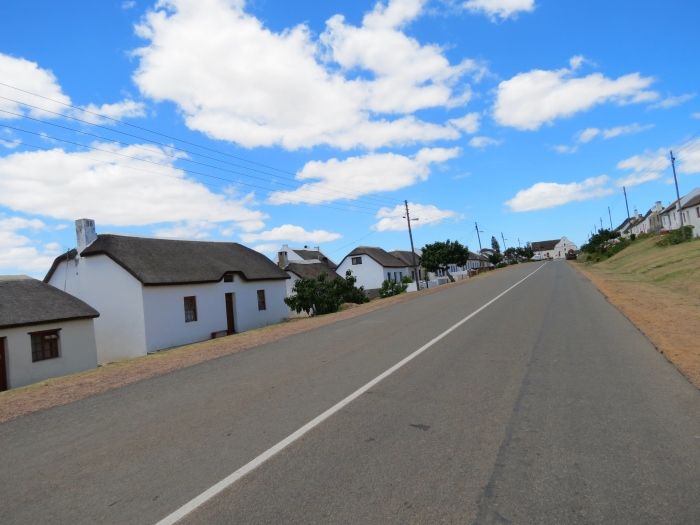
I love it when there is an appreciation of the feel and identity of a town (got that from Tok-tokkie). When the vernacular architecture and history of the town is considered when new buildings are put up or old buildings restored. Elim, Eselbank and to an extent Tulbach are good examples.
But this dude.

Don't get me wrong. The owner of this house takes pride in where he lives. The house is freshly painted, well maintained and has one of the best gardens. But this house is a sore eye in this town. How the powers that be in this community could allow this is beyond me.

We continue on our journey to Baarskeerdersbos. This little hamlet got it's name from small spider-like creatures called “Baardscheerders” (“Beard Shavers”) known for cutting human hair for nest-making purposes. The first written mention of Baardskeerdersbos can be traced to 1660.

Baarskeerdersbos became more widely known among the Afrikaans community because of the success of the Baarskeerdersbos Boereorkes, a farmers orchestra of Manie Groenewald and his merry men.
So what better town to stop for a cooldrink.

Getting closer to Cape Town the towns get bigger and most roads are paved.

We stick to the coastline heading towards Hermanus. Here we see some of the devastation caused by the Stanford Fires that were in the news just before our ride.


But all is not lost. Between us and Cape Town there is still a little piece of gravel I have not been on. A pass no less! Highlands Pass.


As far as passes go (and especially compared to the Southern Cape passes) this is basically just a gravel road over a hill. But there's no traffic and some great views so we'll take it. Beats traffic and tar any day.
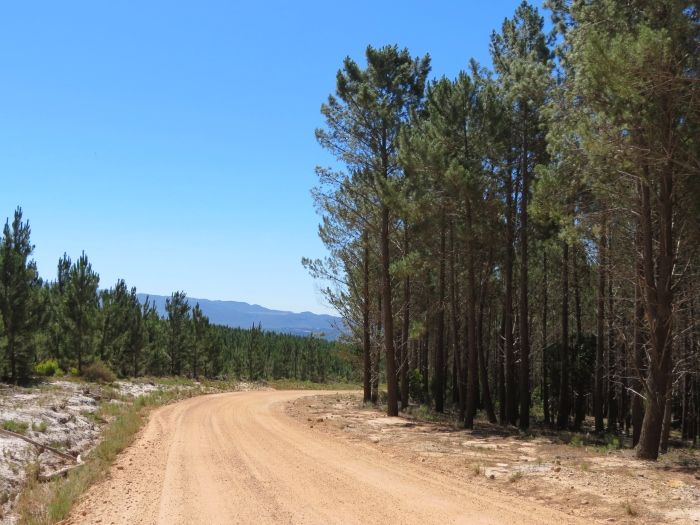

From here on in it's tar and cityscape all the way in. But this is a father and son trip and even in a city you can find things to do. First stop in Somerset West at a bike shop: Royal Enfield
Have a look at these babies.
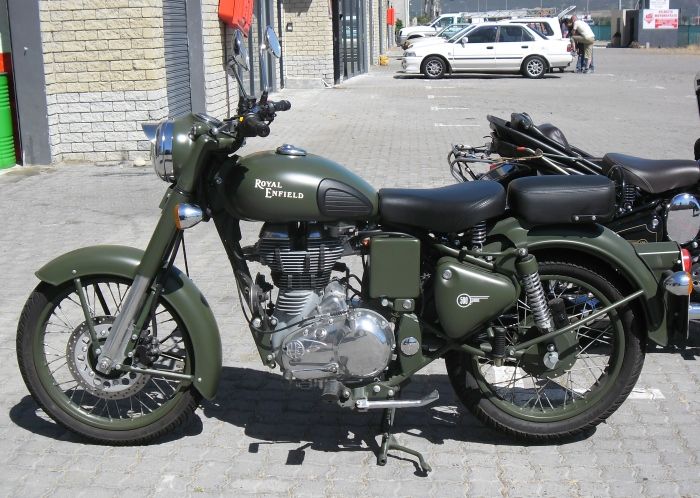
Royal Enfield motorcycles made in England were being sold in India from 1949. In 1955, the Indian government looked for a suitable motorcycle for its police and army, for patrolling the country's border. The Bullet was chosen as the most suitable bike for the job.

An independent manufacturer since the demise of Royal Enfield in England, Enfield India still makes an essentially similar bike in 350 cc and 500 cc forms to this day. They sell these motorcycles in over twenty countries. Not very expensive either.
Check the sidecar versions:

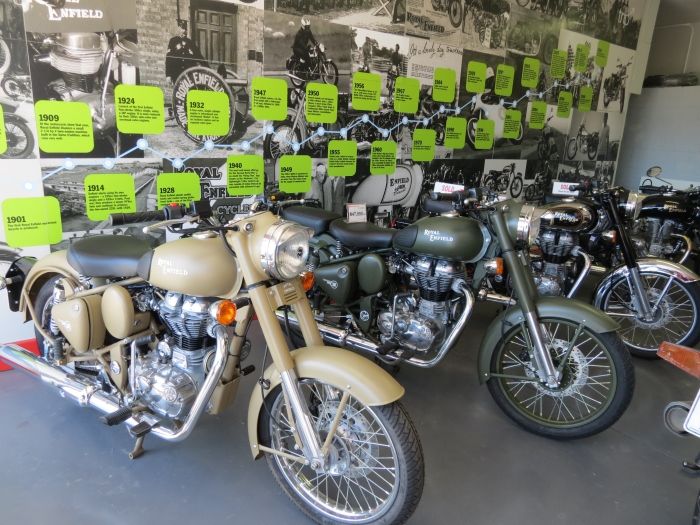
Late in the afternoon we park our bike at my friend Tok-tokkie's place and settle in after a long day in the saddle. A cold beer and a view. And what a view!

It gets even better at night:

All in all a successful day.


No comments:
Post a Comment